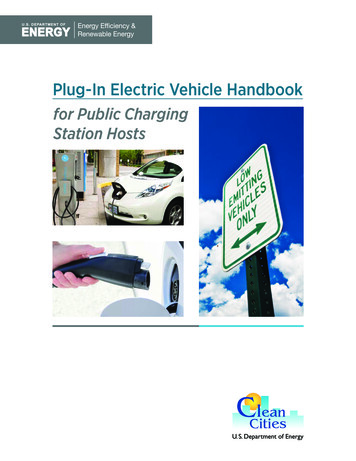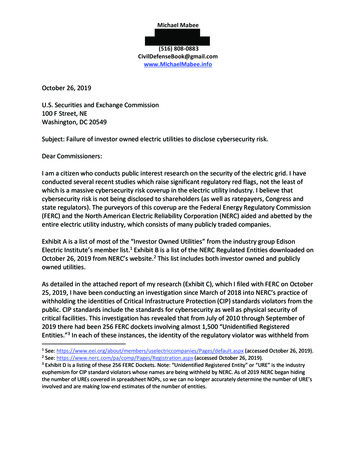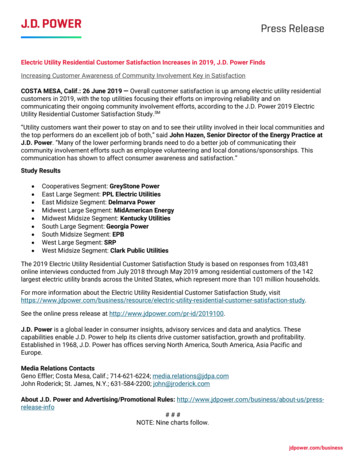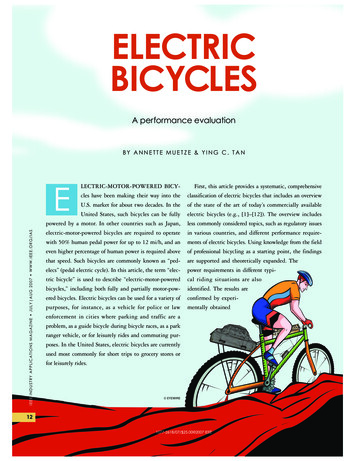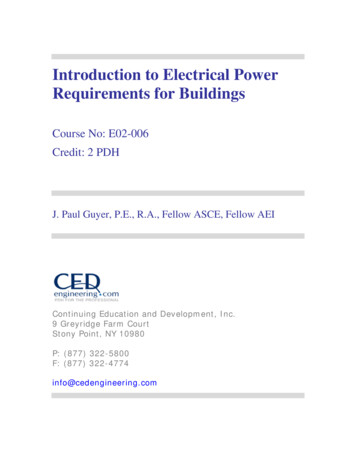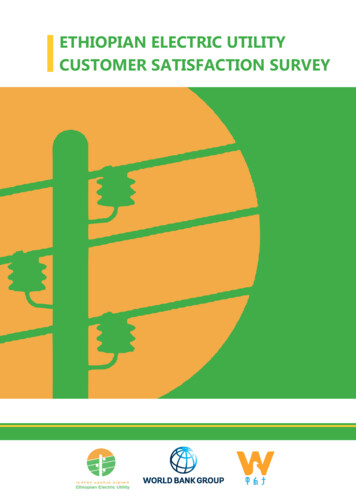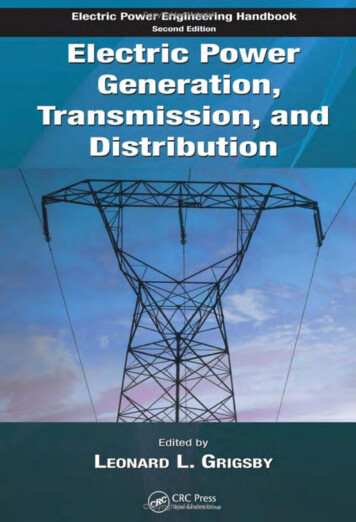
Transcription
Electric Power Engineering HandbookSecond EditionEdited byLeonard L. GrigsbyElectric Power Generation, Transmission, and DistributionEdited by Leonard L. GrigsbyElectric Power Transformer Engineering, Second EditionEdited by James H. HarlowElectric Power Substations Engineering, Second EditionEdited by John D. McDonaldPower SystemsEdited by Leonard L. GrigsbyPower System Stability and ControlEdited by Leonard L. Grigsbyß 2006 by Taylor & Francis Group, LLC.
The Electrical Engineering Handbook SeriesSeries EditorRichard C. DorfUniversity of California, DavisTitles Included in the SeriesThe Handbook of Ad Hoc Wireless Networks, Mohammad IlyasThe Biomedical Engineering Handbook, Third Edition, Joseph D. BronzinoThe Circuits and Filters Handbook, Second Edition, Wai-Kai ChenThe Communications Handbook, Second Edition, Jerry GibsonThe Computer Engineering Handbook, Second Edtion, Vojin G. OklobdzijaThe Control Handbook, William S. LevineThe CRC Handbook of Engineering Tables, Richard C. DorfThe Digital Avionics Handbook, Second Edition Cary R. SpitzerThe Digital Signal Processing Handbook, Vijay K. Madisetti and Douglas WilliamsThe Electrical Engineering Handbook, Third Edition, Richard C. DorfThe Electric Power Engineering Handbook, Second Edition, Leonard L. GrigsbyThe Electronics Handbook, Second Edition, Jerry C. WhitakerThe Engineering Handbook, Third Edition, Richard C. DorfThe Handbook of Formulas and Tables for Signal Processing, Alexander D. PoularikasThe Handbook of Nanoscience, Engineering, and Technology, Second Edition,William A. Goddard, III, Donald W. Brenner, Sergey E. Lyshevski, and Gerald J. IafrateThe Handbook of Optical Communication Networks, Mohammad Ilyas andHussein T. MouftahThe Industrial Electronics Handbook, J. David IrwinThe Measurement, Instrumentation, and Sensors Handbook, John G. WebsterThe Mechanical Systems Design Handbook, Osita D.I. Nwokah and Yidirim HurmuzluThe Mechatronics Handbook, Second Edition, Robert H. BishopThe Mobile Communications Handbook, Second Edition, Jerry D. GibsonThe Ocean Engineering Handbook, Ferial El-HawaryThe RF and Microwave Handbook, Second Edition, Mike GolioThe Technology Management Handbook, Richard C. DorfThe Transforms and Applications Handbook, Second Edition, Alexander D. PoularikasThe VLSI Handbook, Second Edition, Wai-Kai Chenß 2006 by Taylor & Francis Group, LLC.
Electric Power Engineering HandbookSecond EditionELECTRIC POWER GENERATION,TRANSMISSION, and DISTRIBUTIONEdited byLeonard L. Grigsbyß 2006 by Taylor & Francis Group, LLC.
CRC PressTaylor & Francis Group6000 Broken Sound Parkway NW, Suite 300Boca Raton, FL 33487-2742 2007 by Taylor & Francis Group, LLCCRC Press is an imprint of Taylor & Francis Group, an Informa businessNo claim to original U.S. Government worksPrinted in the United States of America on acid-free paper10 9 8 7 6 5 4 3 2 1International Standard Book Number-10: 0-8493-9292-6 (Hardcover)International Standard Book Number-13: 978-0-8493-9292-4 (Hardcover)This book contains information obtained from authentic and highly regarded sources. Reprinted material is quotedwith permission, and sources are indicated. A wide variety of references are listed. Reasonable efforts have been made topublish reliable data and information, but the author and the publisher cannot assume responsibility for the validity ofall materials or for the consequences of their use.No part of this book may be reprinted, reproduced, transmitted, or utilized in any form by any electronic, mechanical, orother means, now known or hereafter invented, including photocopying, microfilming, and recording, or in any information storage or retrieval system, without written permission from the publishers.For permission to photocopy or use material electronically from this work, please access www.copyright.com (http://www.copyright.com/) or contact the Copyright Clearance Center, Inc. (CCC) 222 Rosewood Drive, Danvers, MA 01923,978-750-8400. CCC is a not-for-profit organization that provides licenses and registration for a variety of users. For organizations that have been granted a photocopy license by the CCC, a separate system of payment has been arranged.Trademark Notice: Product or corporate names may be trademarks or registered trademarks, and are used only foridentification and explanation without intent to infringe.Library of Congress Cataloging-in-Publication DataElectric power generation, transmission, and distribution / editor, Leonard Lee Grigsby.p. cm.Includes bibliographical references and index.ISBN-13: 978-0-8493-9292-4 (alk. paper)ISBN-10: 0-8493-9292-6 (alk. paper)1. Electric power production. 2. Electric power distribution. 3. Electric power transmission. I.Grigsby, Leonard L. II. Title.TK1001.E25 2007621.31--dc22Visit the Taylor & Francis Web site athttp://www.taylorandfrancis.comand the CRC Press Web site athttp://www.crcpress.comß 2006 by Taylor & Francis Group, LLC.2007006454
Table of ContentsPrefaceEditorContributorsI Electric Power Generation: Nonconventional Methods1Wind PowerGary L. Johnson2 Advanced Energy TechnologiesSaifur Rahman3 PhotovoltaicsRoger A. MessengerII Electric Power Generation: Conventional Methods4Hydroelectric Power GenerationSteven R. Brockschink, James H. Gurney, and Douglas B. Seely5 Synchronous MachineryPaul I. Nippes6 Thermal Generating PlantsKenneth H. Sebra7 Distributed UtilitiesJohn R. KennedyIII Transmission System89101112Concept of Energy Transmission and DistributionGeorge G. KaradyTransmission Line StructuresJoe C. PohlmanInsulators and AccessoriesGeorge G. Karady and Richard G. FarmerTransmission Line Construction and MaintenanceWilford Caulkins and Kristine BuchholzInsulated Power Cables Used in Underground ApplicationsMichael L. Dyerß 2006 by Taylor & Francis Group, LLC.
13 Transmission Line ParametersManuel Reta-Hernández14 Sag and Tension of ConductorD.A. Douglass and Ridley Thrash15 Corona and NoiseGiao N. Trinh16 Geomagnetic Disturbances and Impacts upon Power System OperationJohn G. Kappenman17 Lightning ProtectionWilliam A. Chisholm18 Reactive Power CompensationRao S. Thallam19 Environmental Impact of Transmission LinesGeorge G. KaradyIV Distribution Systems20 Power System LoadsRaymond R. Shoults and Larry D. Swift21 Distribution System Modeling and AnalysisWilliam H. Kersting22 Power System Operation and ControlGeorge L. Clark and Simon W. Bowen23 Hard to Find Information (on Distribution System Characteristics and Protection)Jim Burke24 Real-Time Control of Distributed GenerationMurat Dilek and Robert P. BroadwaterV Electric Power Utilization25 Metering of Electric Power and EnergyJohn V. Grubbs26 Basic Electric Power Utilization—Loads, Load Characterization and Load ModelingAndrew Hanson27 Electric Power Utilization: MotorsCharles A. GrossVI Power Quality28 IntroductionS.M. Halpin29 Wiring and Grounding for Power QualityChristopher J. Melhorn30 Harmonics in Power SystemsS.M. Halpin31 Voltage SagsMath H.J. Bollen32 Voltage Fluctuations and Lamp Flicker in Power SystemsS.M. Halpinß 2006 by Taylor & Francis Group, LLC.
33 Power Quality MonitoringPatrick Colemanß 2006 by Taylor & Francis Group, LLC.
ß 2006 by Taylor & Francis Group, LLC.
PrefaceThe generation, delivery, and utilization of electric power and energy remain one of the most challenging and exciting fields of electrical engineering. The astounding technological developments of our ageare highly dependent upon a safe, reliable, and economic supply of electric power. The objective ofElectric Power Engineering Handbook, 2nd Edition is to provide a contemporary overview of this farreaching field as well as to be a useful guide and educational resource for its study. It is intended todefine electric power engineering by bringing together the core of knowledge from all of the many topicsencompassed by the field. The chapters are written primarily for the electric power engineeringprofessional who is seeking factual information, and secondarily for the professional from otherengineering disciplines who wants an overview of the entire field or specific information on one aspectof it.The handbook is published in five volumes. Each is organized into topical sections and chapters in anattempt to provide comprehensive coverage of the generation, transformation, transmission, distribution, and utilization of electric power and energy as well as the modeling, analysis, planning, design,monitoring, and control of electric power systems. The individual chapters are different from mosttechnical publications. They are not journal-type chapters nor are they textbook in nature. They areintended to be tutorials or overviews providing ready access to needed information while at the sametime providing sufficient references to more in-depth coverage of the topic. This work is a member ofthe Electrical Engineering Handbook Series published by CRC Press. Since its inception in 1993, thisseries has been dedicated to the concept that when readers refer to a handbook on a particular topic theyshould be able to find what they need to know about the subject most of the time. This has indeed beenthe goal of this handbook.This volume of the handbook is devoted to the subjects of electric power generation by bothconventional and nonconventional methods, transmission systems, distribution systems, power utilization, and power quality. If your particular topic of interest is not included in this list, please refer to thelist of companion volumes seen at the beginning of this book.In reading the individual chapters of this handbook, I have been most favorably impressed by howwell the authors have accomplished the goals that were set. Their contributions are, of course, most keyto the success of the work. I gratefully acknowledge their outstanding efforts. Likewise, the expertise anddedication of the editorial board and section editors have been critical in making this handbookpossible. To all of them I express my profound thanks. I also wish to thank the personnel at Taylor &Francis who have been involved in the production of this book, with a special word of thanks to NoraKonopka, Allison Shatkin, and Jessica Vakili. Their patience and perseverance have made this task mostpleasant.Leo GrigsbyEditor-in-Chiefß 2006 by Taylor & Francis Group, LLC.
ß 2006 by Taylor & Francis Group, LLC.
EditorLeonard L. (‘‘Leo’’) Grigsby received his BS and MS in electrical engineering from Texas Tech Universityand his PhD from Oklahoma State University. He has taught electrical engineering at Texas Tech,Oklahoma State University, and Virginia Polytechnic Institute and University. He has been at AuburnUniversity since 1984 first as the Georgia power distinguished professor, later as the Alabama powerdistinguished professor, and currently as professor emeritus of electrical engineering. He also spent ninemonths during 1990 at the University of Tokyo as the Tokyo Electric Power Company endowed chair ofelectrical engineering. His teaching interests are in network analysis, control systems, and powerengineering.During his teaching career, Professor Grigsby has received 13 awards for teaching excellence.These include his selection for the university-wide William E. Wine Award for Teaching Excellence atVirginia Polytechnic Institute and University in 1980, his selection for the ASEE AT&T Award forTeaching Excellence in 1986, the 1988 Edison Electric Institute Power Engineering Educator Award,the 1990–1991 Distinguished Graduate Lectureship at Auburn University, the 1995 IEEE Region 3Joseph M. Beidenbach Outstanding Engineering Educator Award, the 1996 Birdsong Superior TeachingAward at Auburn University, and the IEEE Power Engineering Society Outstanding Power EngineeringEducator Award in 2003.Professor Grigsby is a fellow of the Institute of Electrical and Electronics Engineers (IEEE). During1998–1999 he was a member of the board of directors of IEEE as director of Division VII for power andenergy. He has served the Institute in 30 different offices at the chapter, section, regional, andinternational levels. For this service, he has received seven distinguished service awards, the IEEECentennial Medal in 1984, the Power Engineering Society Meritorious Service Award in 1994, and theIEEE Millennium Medal in 2000.During his academic career, Professor Grigsby has conducted research in a variety of projects relatedto the application of network and control theory to modeling, simulation, optimization, and control ofelectric power systems. He has been the major advisor for 35 MS and 21 PhD graduates. With hisstudents and colleagues, he has published over 120 technical papers and a textbook on introductorynetwork theory. He is currently the series editor for the Electrical Engineering Handbook Seriespublished by CRC Press. In 1993 he was inducted into the Electrical Engineering Academy at TexasTech University for distinguished contributions to electrical engineering.ß 2006 by Taylor & Francis Group, LLC.
ß 2006 by Taylor & Francis Group, LLC.
ContributorsMath H.J. BollenSTRILudvika, SwedenPatrick ColemanAlabama Power CompanyBirmingham, AlabamaSimon W. BowenAlabama Power CompanyBirmingham, AlabamaMurat DilekElectrical DistributionDesign, Inc.Blacksburg, VirginiaRobert P. BroadwaterVirginia Polytechnic Instituteand State UniversityBlacksburg, VirginiaD.A. DouglassPower Delivery Consultants, Inc.Niskayuna, New YorkSteven R. BrockschinkStantec ConsultingPortland, OregonMichael L. DyerSalt River ProjectPhoenix, ArizonaKristine BuchholzPacific Gas & Electric CompanyDanville, CaliforniaRichard G. FarmerArizona State UniversityTempe, ArizonaJim BurkeInfraSource TechnologyCary, North CarolinaCharles A. GrossAuburn UniversityAuburn, AlabamaWilford CaulkinsSherman & ReillyChattanooga, TennesseeJohn V. GrubbsAlabama Power CompanyBirmingham, AlabamaWilliam A. ChisholmKinectrics UQACToronto, Ontario, CanadaJames H. GurneyBC Transmission CorporationVancouver, British Columbia, CanadaGeorge L. ClarkAlabama Power CompanyBirmingham, AlabamaS.M. HalpinAuburn UniversityAuburn, Alabamaß 2006 by Taylor & Francis Group, LLC.
Andrew HansonPowerComm EngineeringRaleigh, North CarolinaRama RamakumarOklahoma State UniversityStillwater, OklahomaGary L. JohnsonKansas State UniversityManhattan, KansasManuel Reta-HernándezUniversidad Autónomade ZacatecasZacatecas, MexicoJohn G. KappenmanMetatech CorporationDuluth, MinnesotaGeorge G. KaradyArizona State UniversityTempe, ArizonaJohn R. KennedyGeorgia Power CompanyAtlanta, GeorgiaWilliam H. KerstingNew Mexico State UniversityLas Cruces, New MexicoChristopher J. MelhornEPRIKnoxville, TennesseeRoger A. MessengerFlorida Atlantic UniversityBoca Raton, FloridaPaul I. NippesMagnetic Products and Services, Inc.Holmdel, New JerseyJoe C. PohlmanConsultantPittsburgh, PennsylvaniaSaifur RahmanVirginia Polytechnic Instituteand State UniversityAlexandria, Virginiaß 2006 by Taylor & Francis Group, LLC.Kenneth H. SebraBaltimore Gas andElectric CompanyDameron, MarylandDouglas B. SeelyStantec ConsultingPortland, OregonRaymond R. ShoultsUniversity of Texas at ArlingtonArlington, TexasLarry D. SwiftUniversity of Texas at ArlingtonArlington, TexasRao S. ThallamSalt River ProjectPhoenix, ArizonaRidley ThrashSouthwire CompanyCarollton, GeorgiaGiao N. TrinhRetired from Hydro-QuébecInstitute of ResearchBoucherville, Quebec, Canada
IElectric PowerGeneration:NonconventionalMethodsSaifur RahmanVirginia Polytechnic Institute and State University1Wind Power Gary L. Johnson . 1-1Applications . Wind Variability2Advanced Energy Technologies Saifur Rahman . 2-1Storage Systems . Fuel Cells . Summary3Photovoltaics Roger A. Messenger . 3-1Types of PV Cells . PV Applicationsß 2006 by Taylor & Francis Group, LLC.
ß 2006 by Taylor & Francis Group, LLC.
1Wind Power1.1Applications . 1-2Small, Non-Grid ConnectedLarge, Non-Grid ConnectedGary L. JohnsonKansas State University1.2.Small, Grid ConnectedLarge, Grid Connected.Wind Variability . 1-4Land RightsThe wind is a free, clean, and inexhaustible energy source. It has served humankind well for manycenturies by propelling ships and driving wind turbines to grind grain and pump water. Denmark wasthe first country to use wind for generation of electricity. The Danes were using a 23-m diameter windturbine in 1890 to generate electricity. By 1910, several hundred units with capacities of 5 to 25 kW werein operation in Denmark (Johnson, 1985). By about 1925, commercial wind-electric plants using twoand three-bladed propellers appeared on the American market. The most common brands wereWincharger (200 to 1200 W) and Jacobs (1.5 to 3 kW). These were used on farms to charge storagebatteries which were then used to operate radios, lights, and small appliances with voltage ratings of 12,32, or 110 volts. A good selection of 32-VDC appliances was developed by the industry to meet thisdemand.In addition to home wind-electric generation, a number of utilities around the world have builtlarger wind turbines to supply power to their customers. The largest wind turbine built before the late1970s was a 1250-kW machine built on Grandpa’s Knob, near Rutland, Vermont, in 1941. This turbine,called the Smith-Putnam machine, had a tower that was 34 m high and a rotor 53 m in diameter. Therotor turned an ac synchronous generator that produced 1250 kW of electrical power at wind speedsabove 13 m s.After World War II, we entered the era of cheap oil imported from the Middle East. Interest in windenergy died and companies making small turbines folded. The oil embargo of 1973 served as a wakeupcall, and oil-importing nations around the world started looking at wind again. The two most importantcountries in wind power development since then have been the U.S. and Denmark (Brower et al., 1993).The U.S. immediately started to develop utility-scale turbines. It was understood that large turbineshad the potential for producing cheaper electricity than smaller turbines, so that was a reasonabledecision. The strategy of getting large turbines in place was poorly chosen, however. The Department ofEnergy decided that only large aerospace companies had the manufacturing and engineering capabilityto build utility-scale turbines. This meant that small companies with good ideas would not have therevenue stream necessary for survival. The problem with the aerospace firms was that they had no desireto manufacture utility-scale wind turbines. They gladly took the government’s money to build testturbines, but when the money ran out, they were looking for other research projects. The governmentfunded a number of test turbines, from the 100 kW MOD-0 to the 2500 kW MOD-2. These ran for briefperiods of time, a few years at most. Once it was obvious that a particular design would never be costcompetitive, the turbine was quickly salvaged.Denmark, on the other hand, established a plan whereby a landowner could buy a turbine and sell theelectricity to the local utility at a price where there was at least some hope of making money. The earlyß 2006 by Taylor & Francis Group, LLC.
TABLE 1.1Wind Power Installed es were larger than what a farmer would need for himself, but not what we would consider utilityscale. This provided a revenue stream for small companies. They could try new ideas and learn fromtheir mistakes. Many people jumped into this new market. In 1986, there were 25 wind turbinemanufacturers in Denmark. The Danish market gave them a base from which they could also sell toother countries. It was said that Denmark led the world in exports of two products: wind turbines andbutter cookies! There has been consolidation in the Danish industry since 1986, but some of thecompanies have grown large. Vestas, for example, has more installed wind turbine capacity worldwidethan any other manufacturer.Prices have dropped substantially since 1973, as performance has improved. It is now commonplacefor wind power plants (collections of utility-scale turbines) to be able to sell electricity for under fourcents per kilowatt hour.Total installed worldwide capacity at the start of 1999 was almost 10,000 MW, according to the trademagazine Wind Power Monthly (1999). The countries with over 50 MW of installed capacity at that timeare shown in Table 1.1.1.1 ApplicationsThere are perhaps four distinct categories of wind power which should be discussed. These are1.2.3.4.small, non-grid connectedsmall, grid connectedlarge, non-grid connectedlarge, grid connectedBy small, we mean a size appropriate for an individual to own, up to a few tens of kilowatts. Large refersto utility scale.1.1.1Small, Non-Grid ConnectedIf one wants electricity in a location not serviced by a utility, one of the options is a wind turbine, withbatteries to level out supply and demand. This might be a vacation home, a remote antenna andtransmitter site, or a Third-World village. The costs will be high, on the order of 0.50 kWh, but if thetotal energy usage is small, this might be acceptable. The alternatives, photovoltaics, microhydro, anddiesel generators, are not cheap either, so a careful economic study needs to be done for each situation.ß 2006 by Taylor & Francis Group, LLC.
1.1.2 Small, Grid ConnectedThe small, grid connected turbine is usually not economically feasible. The cost of wind-generatedelectricity is less because the utility is used for storage rather than a battery bank, but is still not competitive.In order for the small, grid connected turbine to have any hope of financial breakeven, the turbineowner needs to get something close to the retail price for the wind-generated electricity. One way this isdone is for the owner to have an arrangement with the utility called net metering. With this system, themeter runs backward when the turbine is generating more than the owner is consuming at the moment.The owner pays a monthly charge for the wires to his home, but it is conceivable that the utility willsometimes write a check to the owner at the end of the month, rather than the other way around. Theutilities do not like this arrangement. They want to buy at wholesale and sell at retail. They feel it isunfair to be used as a storage system without remuneration.For most of the twentieth century, utilities simply refused to connect the grid to wind turbines. Theutility had the right to generate electricity in a given service territory, and they would not toleratecompetition. Then a law was passed that utilities had to hook up wind turbines and pay them the avoidedcost for energy. Unless the state mandated net metering, the utility typically required the installation of asecond meter, one measuring energy consumption by the home and the other energy production by theturbine. The owner would pay the regular retail rate, and the utility would pay their estimate of avoidedcost, usually the fuel cost of some base load generator. The owner might pay 0.08 to 0.15 per kWh, andreceive 0.02 per kWh for the wind-generated electricity. This was far from enough to economicallyjustify a wind turbine, and had the effect of killing the small wind turbine business.1.1.3 Large, Non-Grid ConnectedThese machines would be installed on islands or in native villages in the far north where it is virtuallyimpossible to connect to a large grid. Such places are typically supplied by diesel generators, and have asubstantial cost just for the imported fuel. One or more wind turbines would be installed in parallelwith the diesel generators, and act as fuel savers when the wind was blowing.This concept has been studied carefully and appears to be quite feasible technically. One would expectthe market to develop after a few turbines have been shown to work for an extended period in hostileenvironments. It would be helpful if the diesel maintenance companies would also carry a line of windturbines so the people in remote locations would not need to teach another group of maintenancepeople about the realities of life at places far away from the nearest hardware store.1.1.4 Large, Grid ConnectedWe might ask if the utilities should be forced to buy wind-generated electricity from these smallmachines at a premium price which reflects their environmental value. Many have argued this overthe years. A better question might be whether the small or the large turbines will result in a lower netcost to society. Given that we want the environmental benefits of wind generation, should we get theelectricity from the wind with many thousands of individually owned small turbines, or should we use amuch smaller number of utility-scale machines?If we could make the argument that a dollar spent on wind turbines is a dollar not spent on hospitals,schools, and the like, then it follows that wind turbines should be as efficient as possible. Economies ofscale and costs of operation and maintenance are such that the small, grid connected turbine will alwaysneed to receive substantially more per kilowatt hour than the utility-scale turbines in order to breakeven. There is obviously a niche market for turbines that are not connected to the grid, but small, gridconnected turbines will probably not develop a thriving market. Most of the action will be from theutility-scale machines.Sizes of these turbines have been increasing rapidly. Turbines with ratings near 1 MWare now common,with prototypes of 2 MW and more being tested. This is still small compared to the needs of a utility, soclusters of turbines are placed together to form wind power plants with total ratings of 10 to 100 MW.ß 2006 by Taylor & Francis Group, LLC.
1.2 Wind VariabilityOne of the most critical features of wind generation is the variability of wind. Wind speeds vary withtime of day, time of year, height above ground, and location on the earth’s surface. This makes windgenerators into what might be called energy producers rather than power producers. That is, it is easierto estimate the energy production for the next month or year than it is to estimate the power that will beproduced at 4:00 PM next Tuesday. Wind power is not dispatchable in the same manner as a gas turbine.A gas turbine can be scheduled to come on at a given time and to be turned off at a later time, with fullpower production in between. A wind turbine produces only when the wind is available. At a good site,the power output will be zero (or very small) for perhaps 10% of the time, rated for perhaps another10% of the time, and at some intermediate value the remaining 80% of the time.This variability means that some sort of storage is necessary for a utility to meet the demands of itscustomers, when wind turbines are supplying part of the energy. This is not a problem for penetrationsof wind turbines less than a few percent of the utility peak demand. In small concentrations, windturbines act like negative load. That is, an increase in wind speed is no different in its effect than acustomer turning off load. The control systems on the other utility generation sense that generation isgreater than load, and decrease the fuel supply to bring generation into equilibrium with load. In thiscase, storage is in the form of coal in the pile or natural gas in the well.An excellent form of storage is water in a hydroelectric lake. Most hydroelectric plants are sized largeenough to not be able to operate full-time at peak power. They therefore must cut back part of the timebecause of the lack of water. A combination hydro and wind plant can conserve water when the wind isblowing, and use the water later, when the wind is not blowing.When high-temperature superconductors become a little less expensive, energy storage in a magneticfield will be an exciting possibility. Each wind turbine can have its own superconducting coil storageunit. This immediately converts the wind generator from an energy producer to a peak power producer,fully dispatchable. Dispatchable peak power is always worth more than the fuel cost savings of an energyproducer. Utilities with adequate base load generation (at low fuel costs) would become more interestedin wind power if it were a dispatchable peak power generator.The variation of wind speed with time of day is called the diurnal cycle. Near the earth’s surface, windsare usually greater during the middle of the day and decrease at night. This is due to solar heating, whichcauses ‘‘bubbles’’ of warm air to rise. The rising air is replaced by cooler air from above. This thermalmixing causes wind speeds to have only a slight increase with height for the first hundred meters or soabove the earth. At night, however, the mixing stops, the air near the earth slows to a stop, and the windsabove some height (usually 30 to 100 m) actually increase over the daytime value. A turbine on a shorttower will produce a greater proportion of its energy during daylight hours, while a turbine on a verytall tower will produce a greater proportion at night.As tower height is increased, a given generator will produce substantially more energy. However, mostof the extra energy will be produced at night, when it is not worth very much. Standard heights havebeen increasing in recent years, from 50 to 65 m or even more. A taller tower gets the blades into lessturbulent air, a definite advantage. The disadvantages are extra cost and more danger from overturningin high winds. A very careful look should be given the economics before buying a tower that issignificantly taller than whatever is sold a
The Electrical Engineering Handbook Series Series Editor Richard C. Dorf University of California, Davis Titles Included in the Series The Handbook of Ad Hoc Wireless Networks, Mohammad Ilyas The Biomedical Engineering Handbook, Third Edition, Joseph D. Bronzino The Circuits and Filters Handbook, Second Edition, Wai-Kai Chen The Communications Handbook, Second Edition, Jerry Gibson
